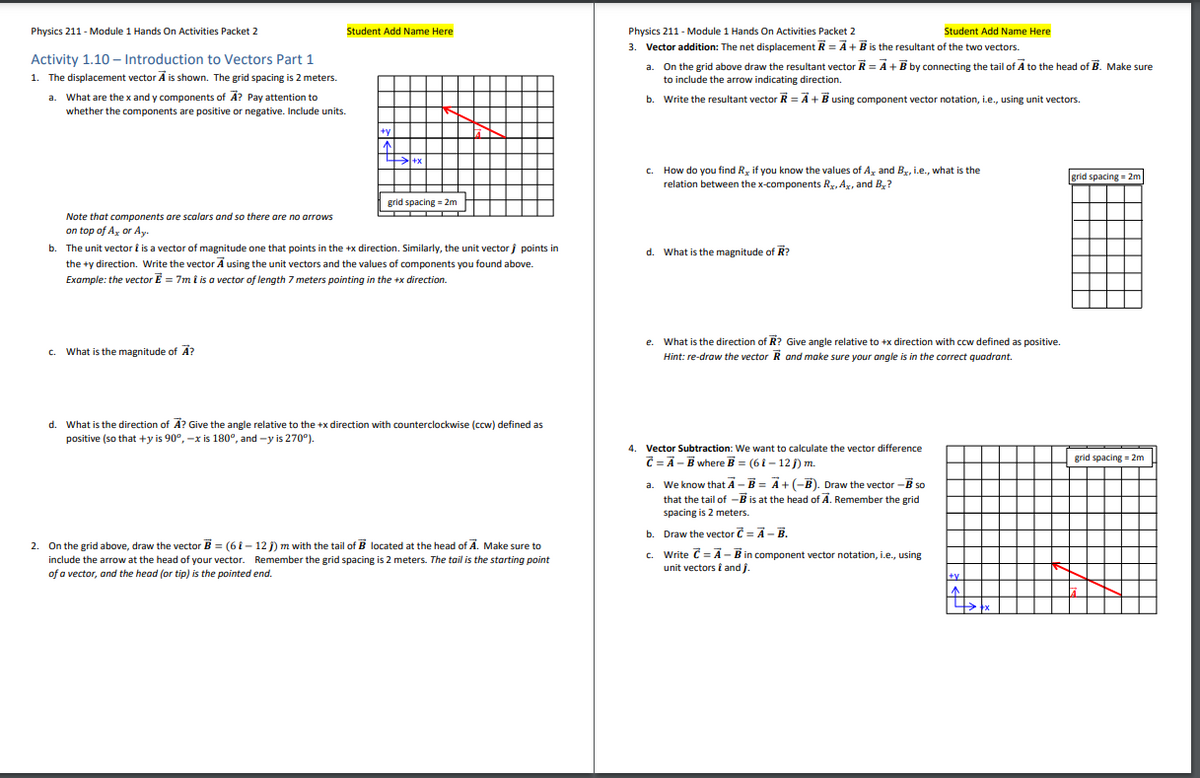4. Vector Subtraction: We want to calculate the vector difference C=A-B where B = (6i-12j) m. a. We know that A - B = A + (-B). Draw the vector - B so that the tail of --B is at the head of A. Remember the grid spacing is 2 meters. Draw the vector C=A-B. Write C = A - B in component vector notation, i.e., using unit vectors i and j b. c. grid spacing - 2m
4. Vector Subtraction: We want to calculate the vector difference C=A-B where B = (6i-12j) m. a. We know that A - B = A + (-B). Draw the vector - B so that the tail of --B is at the head of A. Remember the grid spacing is 2 meters. Draw the vector C=A-B. Write C = A - B in component vector notation, i.e., using unit vectors i and j b. c. grid spacing - 2m
Physics for Scientists and Engineers: Foundations and Connections
1st Edition
ISBN:9781133939146
Author:Katz, Debora M.
Publisher:Katz, Debora M.
Chapter3: Vectors
Section: Chapter Questions
Problem 65PQ
Related questions
Question
100%
Hi I am looking for help with problem #4

Transcribed Image Text:Physics 211 - Module 1 Hands On Activities Packet 2
Activity 1.10 - Introduction to Vectors Part 1
1. The displacement vector A is shown. The grid spacing is 2 meters.
a.
What are the x and y components of A? Pay attention to
whether the components are positive or negative. Include units.
Note that components are scalars and so there are no arrows
on top of Ax or Ay.
Student Add Name Here
c. What is the magnitude of A?
+y
^
→→→+x
grid spacing= 2m
b. The unit vector i is a vector of magnitude one that points in the +x direction. Similarly, the unit vector / points in
the +y direction. Write the vector A using the unit vectors and the values of components you found above.
Example: the vector E = 7m i is a vector of length 7 meters pointing in the +x direction.
d. What is the direction of A? Give the angle relative to the +x direction with counterclockwise (ccw) defined as
positive (so that +y is 90°, -x is 180°, and -y is 270º).
2. On the grid above, draw the vector B = (6 - 12 j) m with the tail of B located at the head of A. Make sure to
include the arrow at the head of your vector. Remember the grid spacing is 2 meters. The tail is the starting point
of a vector, and the head (or tip) is the pointed end.
Physics 211 - Module 1 Hands On Activities Packet 2
Student Add Name Here
3. Vector addition: The net displacement R = A + B is the resultant of the two vectors.
a. On the grid above draw the resultant vector R = A + B by connecting the tail of A to the head of B. Make sure
to include the arrow indicating direction.
b. Write the resultant vector R = A + B using component vector notation, i.e., using unit vectors.
c. How do you find R, if you know the values of A and Bx, i.e., what is the
relation between the x-components Rx, Ax, and Bx?
d. What is the magnitude of R?
e.
What is the direction of R? Give angle relative to +x direction with ccw defined as positive.
Hint: re-draw the vector R and make sure your angle is in the correct quadrant.
4. Vector Subtraction: We want to calculate the vector difference
C = A - B where B= (61-12 j) m.
a.
We know that A - B = A + (-B). Draw the vector -B so
that the tail of -B is at the head of A. Remember the grid
spacing is 2 meters.
b. Draw the vector C = A - B.
c. Write C=A-B in component vector notation, i.e., using
unit vectors i and j.
+y
↑
grid spacing= 2m
grid spacing= 2m
Expert Solution
This question has been solved!
Explore an expertly crafted, step-by-step solution for a thorough understanding of key concepts.
This is a popular solution!
Trending now
This is a popular solution!
Step by step
Solved in 5 steps with 2 images

Knowledge Booster
Learn more about
Need a deep-dive on the concept behind this application? Look no further. Learn more about this topic, physics and related others by exploring similar questions and additional content below.Recommended textbooks for you

Physics for Scientists and Engineers: Foundations…
Physics
ISBN:
9781133939146
Author:
Katz, Debora M.
Publisher:
Cengage Learning

Physics for Scientists and Engineers
Physics
ISBN:
9781337553278
Author:
Raymond A. Serway, John W. Jewett
Publisher:
Cengage Learning

Physics for Scientists and Engineers with Modern …
Physics
ISBN:
9781337553292
Author:
Raymond A. Serway, John W. Jewett
Publisher:
Cengage Learning

Physics for Scientists and Engineers: Foundations…
Physics
ISBN:
9781133939146
Author:
Katz, Debora M.
Publisher:
Cengage Learning

Physics for Scientists and Engineers
Physics
ISBN:
9781337553278
Author:
Raymond A. Serway, John W. Jewett
Publisher:
Cengage Learning

Physics for Scientists and Engineers with Modern …
Physics
ISBN:
9781337553292
Author:
Raymond A. Serway, John W. Jewett
Publisher:
Cengage Learning

Physics for Scientists and Engineers, Technology …
Physics
ISBN:
9781305116399
Author:
Raymond A. Serway, John W. Jewett
Publisher:
Cengage Learning

College Physics
Physics
ISBN:
9781305952300
Author:
Raymond A. Serway, Chris Vuille
Publisher:
Cengage Learning

Principles of Physics: A Calculus-Based Text
Physics
ISBN:
9781133104261
Author:
Raymond A. Serway, John W. Jewett
Publisher:
Cengage Learning